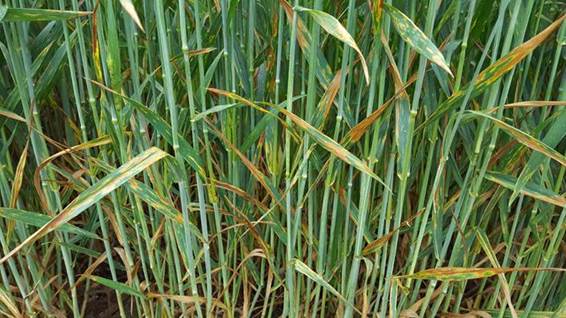
Agricultural News
Dr. Bob Hunger Continues to See Foliar Diseases on the Rise in Oklahoma Wheat Fields
Fri, 03 May 2019 22:25:26 CDT
 The following update is provided by Dr. Bob Hunger, Extension Wheat Pathologist for Oklahoma State University. Dr. Hunger continues to see the rise of wheat foliar diseases even as the crop nears maturity.
The following update is provided by Dr. Bob Hunger, Extension Wheat Pathologist for Oklahoma State University. Dr. Hunger continues to see the rise of wheat foliar diseases even as the crop nears maturity.
"Reports and observations of foliar diseases increased this past week. Around Stillwater, wheat ranges from heads nearly or completely emerged to full kernel (watery). On this wheat, higher levels of leaf and stripe rust were observed in various trials and nurseries. There seems to be more chlorosis/yellowing associated with these foliar diseases than in most years. Septoria also is widespread around Stillwater as it is around much of the state. At a field day on May first near Apache, OK in Caddo County (central OK), low levels of active stripe rust and leaf rust were observed on susceptible varieties, but by far the most prevalent disease was septoria.
"Typically the leaf spot diseases (primarily septoria and tan spot) do not move much above the lower leaves, and by this time in May drier weather and higher temperature prevent these diseases from moving up the canopy. However, this year the extended and consistent cloudy, cool and wet conditions have obviously favored septoria to the point that septoria could be found on the leaf just under the flag (but not near as severe as on the lower and mid leaves). There is benefit from applying a fungicide sufficiently early to help manage septoria. For more information on applying fungicides and their relative effectiveness in managing foliar diseases, see OCES Current Report (CR-7668) that can be found by clicking or tapping here.
"Another symptom that is becoming more apparent across Oklahoma is physiological leaf spot (PLS), which we tend to see in years with extended cool and wet weather. This type of spotting often is attributed to rust infection as when you look "through" the leaf the spots appear to be about the same as a leaf rust pustule. However, in past years I have taken such plants to the greenhouse and rust never developed. I've never seen any papers indicating how much harm PLS can inflect, nor any suggestions to take to reduce or control its occurrence. In most years and places I have seen it occur, its effect on yield appears to be minimal. However, typically I've seen it occur in early to mid-April rather than in early to mid-May.
"So to summarize, wheat foliar diseases are increasing across Oklahoma with septoria being the primary leaf spot disease that is being reported. Persistent wet and cool weather has facilitated movement of septoria up from the lower level foliage into the mid and even to some extent onto upper leaves. There are a number of effective fungicides for these leaf spot diseases, and although application likely would have been most beneficial 7-10 days ago, protection of the flag leaf is most critical. Stripe rust and leaf rust also are increasing. All of these foliar diseases can be managed with fungicides, but the window to legally apply fungicides onto wheat (especially in southern OK) is closing (or may have closed). Hence, be sure to read the label closely and find a chemical that allows application related to the stage of the wheat. Some fungicides use a growth stage deadline (for example start of flowering or end of flowering), and some use a number of days that must pass between application and harvest (post-application harvest restriction). Also keep in mind the reaction of the variety to these diseases. For example, if your wheat is at or near flowering (heads fully emerged), has good resistance to leaf and stripe rust, and is not showing any or much leaf spotting, applying a fungicide would not be indicated. In contrast, applying a fungicide would be indicated if you have a variety that has good yield potential, is susceptible or moderately susceptible to the rusts and is showing heavy leaf spotting on lower and mid leaves."
WebReadyTM Powered by WireReady® NSI
Top Agricultural News
More Headlines...





